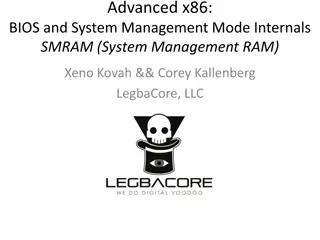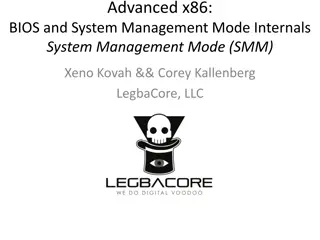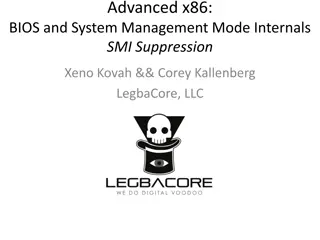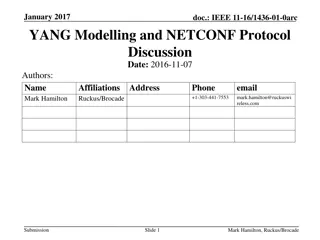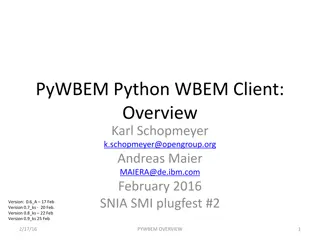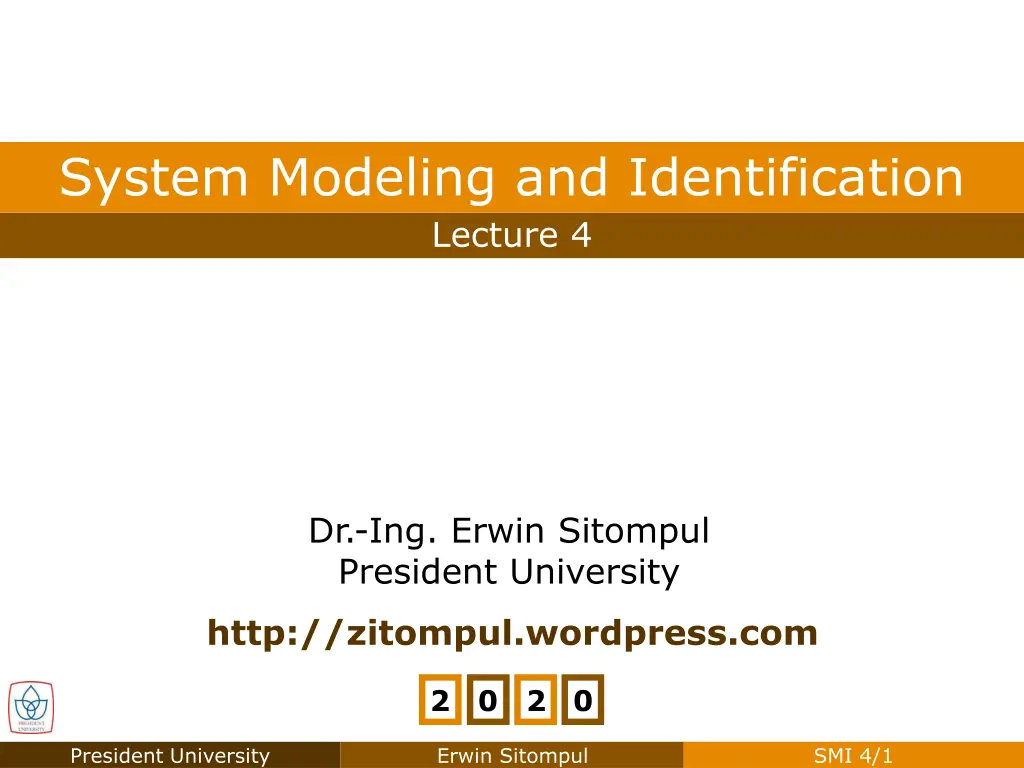
Linearization and System Modeling Solutions by Dr. Erwin Sitompul
Explore the detailed solutions for linearization and system modeling tasks provided by Dr. Erwin Sitompul from President University. The content includes step-by-step explanations, formulas, and illustrations for better understanding.
Download Presentation

Please find below an Image/Link to download the presentation.
The content on the website is provided AS IS for your information and personal use only. It may not be sold, licensed, or shared on other websites without obtaining consent from the author. If you encounter any issues during the download, it is possible that the publisher has removed the file from their server.
You are allowed to download the files provided on this website for personal or commercial use, subject to the condition that they are used lawfully. All files are the property of their respective owners.
The content on the website is provided AS IS for your information and personal use only. It may not be sold, licensed, or shared on other websites without obtaining consent from the author.
E N D
Presentation Transcript
System Modeling and Identification Lecture 4 Dr.-Ing. Erwin Sitompul President University http://zitompul.wordpress.com 2 0 2 0 President University Erwin Sitompul SMI 4/1
Chapter 2 Linearization Homework 3 Linearize the the interacting tank-in-series system for the operating point resulted by the parameter values as given in Homework 2. For qi, use the last digit of your Student ID. For example: Kartika qi= 8 liters/s. Submit the mdl-file and the screenshots of the Matlab-Simulink file + scope. qi h1 h2 q1 a1 a2 v1 v2 President University Erwin Sitompul SMI 4/2
Chapter 2 Linearization Solution to Homework 3 The model of the system is: q A a A a A = = ( , f h h q , ) 2 ( g h ) h h i 1 1 1 2 i 1 1 2 1 1 a A = = ( , , ) f h h q 2 ( g h ) 2 h h gh 1 2 2 1 2 i 2 1 2 2 2 2 = = ( , , ) y h g h h q 1 1 1 1 2 i = = ( , , ) g h h q y h 2 1 2 i 2 2 As can be seen from the result of Homework 2, the steady state parameter values, which are taken to be the operating point, are: = = 0.638 m 0.319 m 5 10 m s = h h 1,0 2,0 q 3 3 i,0 President University Erwin Sitompul SMI 4/3
Chapter 2 Linearization Solution to Homework 3 The linearization around the operating point (h1,0, h2,0, qi,0) is performed as follows: 2 9.8 3 1 2 2 f h a A g 1 2 10 2 0.25 0.03135 = = = 1 1 ( ) h h (0.638 0.319) h h 1,0 2,0 i,0 q 1 1 1,0 2,0 2 9.8 3 1 2 2 f h a A g 1 2 10 2 0.25 = = = 1 1 0.03135 ( ) h h (0.638 0.319) h h 1,0 2,0 i,0 q 2 1 1,0 2,0 1 A f q 1 = = = 1 4 0.25 h h 1,0 2,0 i,0 q i 1 President University Erwin Sitompul SMI 4/4
Chapter 2 Linearization Solution to Homework 3 2 9.8 3 1 2 2 f h a A g 1 2 10 2 = = = 0.07838 2 1 ( ) h h 0.1 (0.638 0.319) h h 1,0 2,0 i,0 q 1 2 1,0 2,0 1 2 2 1 2 2 h f h a A a A g g = 2 1 2 ( ) h h h h 1,0 2,0 i,0 q 2 2 1,0 2,0 2 2,0 2 9.8 3 3 1 2 10 2 1 2 10 2 2 9.8 0.319 = 0.1 (0.638 0.319) 0.1 0.15677 = f q = 0 2 h h 1,0 2,0 i,0 q i President University Erwin Sitompul SMI 4/5
Chapter 2 Linearization Solution to Homework 3 ( ) = + h A h B ( ) t ( ) t ( ) q t i f h f h f h f h f q f q 1 1 1 ( ( ) ) = h t ( ) ( ) ( ) h t h t 1 1 2 1 1 + ( ) q t i h t ( ) 2 2 2 2 2 1 2 1 ( ( ) ) = h t ( ) ( ) ( ) 0.03135 0.07838 0.03135 0.15677 4 0 h t h t 1 1 + ( ) q t i h t ( ) 2 2 President University Erwin Sitompul SMI 4/6
Chapter 2 Linearization Solution to Homework 3 = + y C h D ( ) t ( ) t ( ) q t i g h g h g h g h g q g q 1 1 1 ( ) ( ) ( ) ( ) h t h t h t h t 1 2 1 1 1 = + ( ) q t i 2 2 2 2 2 1 2 1 ( ) ( ) ( ) ( ) 1 0 0 1 0 0 h t h t h t h t 1 1 = + ( ) q t i 2 2 President University Erwin Sitompul SMI 4/7
Chapter 2 Linearization Solution to Homework 3 President University Erwin Sitompul SMI 4/8
Chapter 2 Linearization Solution to Homework 3 = = = q h h q h i i,0 1 1,0 h 2 2,0 : h1, original model : h2, original model : h1, linearized model : h2, linearized model President University Erwin Sitompul SMI 4/9
Chapter 2 Linearization Solution to Homework 3 = q q i i,0 5.5 liters s : h1, original model : h2, original model : h1, linearized model : h2, linearized model President University Erwin Sitompul SMI 4/10
Chapter 2 Linearization Solution to Homework 3 = q q i i,0 7.5 liters s : h1, original model : h2, original model : h1, linearized model : h2, linearized model President University Erwin Sitompul SMI 4/11
System Modeling and Identification Chapter 3 Analysis of Process Models President University Erwin Sitompul SMI 4/12
Chapter 3 Analysis of Process Models State Space Process Models Consider a continuous-time MIMO system with m input variables and r output variables. The relation between input and output variables can be expressed as: ( ) ( ), ( ) t t dt ( ) ( ) ( ), ( ) t t t = y g x u d t x ( ) = f x u x u ( ) ( ) ( ) t y t t : vector of state space variables : vector of input variables : vector of output variables President University Erwin Sitompul SMI 4/13
Chapter 3 State Space Process Models Solution of State Space Equations Consider the state space equations: d t x ( ) dt ( ) y = + = Ax Bu x x ( ) t ( ), (0) t 0 = Cx ( ) t t Taking the Laplace Transform yields: = + X x AX BU ( ) s ( ) s ( ) s s 0 = + 1 1 X I A x I A BU ( ) s ( ) ( ) ( ) s s s 0 ( ) = + 1 1 Y C I A x I A BU ( ) s ( ) (0) ( ) ( ) s s s President University Erwin Sitompul SMI 4/14
Chapter 3 Solution of State Space Equations State Space Process Models After the inverse Laplace transformation, t t t e e = + t t t e = + ( ) A A ( ) t x x Bu ( ) (0) d 0 ( ) A A ( ) t y C x C Bu ( ) (0) e d 0 = A 1 1 t L I A ( ) e s The solution of state space equations depends on the roots of the characteristic equation: det( ) 0 s = I A President University Erwin Sitompul SMI 4/15
Chapter 3 Solution of State Space Equations State Space Process Models 1 1 2 = A Consider a matrix . 0 eA Calculate . t L 1 + 1 1 + s = A 1 t e 0 2 s + + 2 1 s 1 1 + = 1 L 1 + s 0 1 s det 0 2 s 1 + 1 s 2 + + t t t e e e 1 ( 1)( 2) s s = 1 A= L t e 2 t 0 1 + e 0 2 s President University Erwin Sitompul SMI 4/16
Chapter 3 State Space Process Models Canonical Transformation If A is available in its canonical form, the state space model will be in the simples form for further analysis. For that, we need to transform A so that it will only have non-zero main diagonal components. Eigenvalues of A, 1, , n are given as solutions of the equation det(A I) = 0. If the eigenvalues of A are distinct, then a nonsingular matrix T exists, such that: 1 = T AT is a diagonal matrix of the form 0 0 t 0 0 e 1 1 0 t 0 e 2 2 = = = 1 1 t L I ( ) e s 0 0 0 0 t 0 0 e n n President University Erwin Sitompul SMI 4/17
Chapter 3 State Space Process Models Equivalent State Equations Consider an n-dimensional state space equations: = = + + x y Ax Cx Bu Du ( ) t ( ) t ( ) t ( ) t ( ) t ( ) t Let P be an n n real nonsingular matrix, and let x = P x. Then, the state space equations ( ) ( ) ( ) t t t = + x Ax Bu ~ = + y Cx Du ( ) t ( ) t ( ) t where A = = 1, 1, B PB D D = = , . PAP C CP is said to be algebraically equivalent with the original state space equations. ~ x = P x is called an equivalence transformation. President University Erwin Sitompul SMI 4/18
Chapter 3 State Space Process Models Equivalent State Equations Proof: Substituting 1 = x P x ( ) t ( ) t 1 1 = + P x AP x Bu ( ) t ( ) t ( ) t 1 = + x PAP x PBu ( ) t ( ) t ( ) t A B 1 = + y CP x Du ( ) t ( ) t ( ) t C D President University Erwin Sitompul SMI 4/19
Chapter 3 State Space Process Models Canonical Transformation Example Perform the canonical transformation to the state space equations below 1 4 1 4 13 4 ( ) 0 3 0 ( ) 1 0 0 2 1 ( ) 1 0 0 ( ) y t t = x = + x x ( ) t t u t = A I det( ) 0 1 4 1 4 0 2 = )( 3 1 3 2 )( 2 = ( 1 = = = ) det 0 0 3 0 0 1 The eigenvalues of A 2 3 President University Erwin Sitompul SMI 4/20
Chapter 3 State Space Process Models Canonical Transformation = 0 1 4 0 1 A 0 0 0 I e ( ) 0 0 0 1 1 4 2 1 e e e 1 0 0 = 0 0 11 2 = = e 0 0 0 1 21 3 0 0 0 1 31 = 0 0 3 = 0 1 4 0 1 A 2 0 0 I e ( ) 0 2 2 2 4 0 0 2 1 0 = e e e 12 = e The eigenvectors of A 0 2 22 32 = T e e e 1 2 3 = 0 1 4 0 0 A 1 0 0 I e ( ) 3 3 4 1 0 1 0 0 2 1 0 1 0 4 e e e 1 0 4 13 = = = e 0 3 23 33 President University Erwin Sitompul SMI 4/21
State Space Process Models Canonical Transformation The equivalence transformation can now be done, with x = Tx. Then, the state space equations 1 0 0 0 3 0 0 0 2 1 , 1 0.25 Chapter 3 ~ 1 0 0 2 1 0 1 0 4 1 = = = A T AT = T 1 0 0 2 0.25 0 0.25 = = 1 = = C CT 1 2 1 B T B 1 = T 1 0 As the result, we obtain a state space in canonical form, 1 0 0 ( ) 0 3 0 0 0 2 ( ) 1 2 1 ( ) y t t = x 1 1 = + x x ( ) t ( ) t u t 0.25 President University Erwin Sitompul SMI 4/22
Chapter 3 State Space Process Models Homework 4 Make yourself familiar with the canonical transformation. Obtain the canonical form of the state space below through manual calculation. 0 19 1 0 30 0 0 1 0 0 = + x x ( ) t 0 1 ( ) t ( ) u t = x ( ) y t 0 2 1 ( ) t President University Erwin Sitompul SMI 4/23
Chapter 3 State Space Process Models Homework 4A Perform manual calculation of the canonical transformation for the following state space equation. 0 0 1 0 11 0 1 0 0 1 = + x x ( ) t ( ) t ( ) u t 6 6 = x ( ) y t 20 9 1 ( ) t Chose the eigenvectors such that the t11 (the first row and first column) of T equals your Student ID and t12 (the first row and first column) of T equals your Birth Month. St-ID free free Birth month free free 1 = T free free Hint: Learn the following functions in Matlab: [V,D] = eig(X) Deadline: One day before the next lecture. President University Erwin Sitompul SMI 4/24

